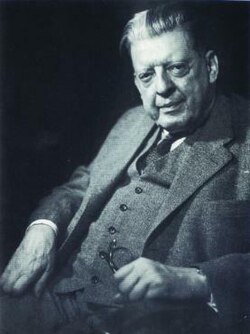Wilhelm Blaschke
Austrian mathematician (1885–1962) From Wikipedia, the free encyclopedia
Wilhelm Johann Eugen Blaschke (13 September 1885 – 17 March 1962) was an Austrian mathematician working in the fields of differential and integral geometry.
You can help expand this article with text translated from the corresponding article in German. (December 2009) Click [show] for important translation instructions.
|
Wilhelm Blaschke | |
|---|---|
 | |
| Born | 13 September 1885 |
| Died | 17 March 1962 (aged 76) |
| Nationality | Austrian |
| Alma mater | University of Vienna |
| Known for | Blaschke product Blaschke selection theorem Blaschke–Santaló inequality |
| Scientific career | |
| Fields | Mathematics |
| Institutions | University of Hamburg |
| Doctoral advisor | Wilhelm Wirtinger |
| Doctoral students | Shiing-Shen Chern Luis Santaló Emanuel Sperner Gerhard Thomsen |
| Other notable students | Alberto Dou Mas de Xaxàs |
Education and career
Summarize
Perspective
Blaschke was the son of mathematician Josef Blaschke, who taught geometry at the Landes Oberrealschule in Graz. After studying for two years at the Technische Hochschule in Graz, he went to the University of Vienna, and completed a doctorate in 1908 under the supervision of Wilhelm Wirtinger.[1] His dissertation was Über eine besondere Art von Kurven vierter Klasse.[2]
After completing his doctorate he spent several years visiting mathematicians at the major universities in Italy and Germany. He spent two years each in positions in Prague, Leipzig, Göttingen, and Tübingen until, in 1919, he took the professorship at the University of Hamburg that he would keep for the rest of his career.[1] His students at Hamburg included Shiing-Shen Chern, Luis Santaló, and Emanuel Sperner.[2]
In 1933 Blaschke signed the Vow of allegiance of the Professors of the German Universities and High-Schools to Adolf Hitler and the National Socialistic State.[3][4] However, he defended Kurt Reidemeister against the Nazis and, in the early 1930s, campaigned against Ludwig Bieberbach for leadership of the German Mathematical Society, arguing that the society should remain international and apolitical in opposition to Bieberbach's wish to "enforce Nazi policies on German mathematics and race". However, by 1936 he was supporting Nazi policies, called himself "a Nazi at Heart", and was described by colleagues as "Mussolinetto" for his fascist beliefs.[1] He officially joined the Nazi Party in 1937.[3]
After the war, Blaschke was removed from his position at the University of Hamburg for his Nazi affiliation, but after an appeal his professorship was restored in 1946.[1] He remained at the university until his retirement in 1953.[1]
Publications
Summarize
Perspective
In 1916 Blaschke published one of the first books devoted to convex sets: Circle and Sphere (Kreis und Kugel). Drawing on dozens of sources, Blaschke made a thorough review of the subject with citations within the text to attribute credit in a classical area of mathematics.
- Kreis und Kugel, Leipzig, Veit 1916;[5] 3rd edn. Berlin, de Gruyter 1956
- Vorlesungen über Differentialgeometrie, 3 vols., Springer, Grundlehren der mathematischen Wissenschaften 1921-1929 (vol. 1, Elementare Differentialgeometrie;[6] vol. 2, Affine Differentialgeometrie; vol. 3, Differentialgeometrie der Kreise und Kugeln, 1929)
- with G. Bol: Geometrie der Gewebe. Berlin: Springer 1938[7]
- Ebene Kinematik. Leipzig: B.G. Teubner 1938,[8] 2nd expanded edn. with Hans Robert Müller, Oldenbourg, München 1956
- Nicht-Euklidische Geometrie und Mechanik I, II, III. Leipzig: B.G.Teubner (1942)
- Zur Bewegungsgeometrie auf der Kugel. In: Sitzungsberichte der Heidelberger Akademie der Wissenschaften (1948)
- Einführung in die Differentialgeometrie. Springer 1950,[9] 2nd expanded edn. with H. Reichardt 1960
- with Kurt Leichtweiß: Elementare Differentialgeometrie. Berlin: Springer (5th edn. 1973)
- Reden und Reisen eines Geometers. Berlin : VEB Deutscher Verlag der Wissenschaften (1961; 2nd expanded edn.)
- Mathematik und Leben, Wiesbaden, Steiner 1951
- Griechische und anschauliche Geometrie, Oldenbourg 1953
- Projektive Geometrie, 3rd edn, Birkhäuser 1954
- Analytische Geometrie, 2nd edn., Birkhäuser 1954
- Einführung in die Geometrie der Waben, Birkhäuser 1955[10]
- Vorlesungen über Integralgeometrie, VEB, Berlin 1955
- Reden und Reisen eines Geometers, 1957
- Kinematik und Quaternionen. Berlin: VEB Deutscher Verlag der Wissenschaften (1960)
- Gesammelte Werke, Thales-Verlag, Essen 1982 vol. 1 ISBN 3889082017;[11] 1985 vol. 2 ISBN 3889082025; 1985 vol. 3 ISBN 3889082033
Eponyms
Blaschke's name has been lent as an eponym to a number of mathematical theorems and concepts:
- Blaschke selection theorem
- Blaschke–Lebesgue theorem
- Blaschke product
- Blaschke sum
- Blaschke condition
- Blaschke–Busemann measure
- Blaschke–Santaló inequality
- Blaschke conjecture: "The only Wiedersehen manifolds in any dimension are the standard Euclidean spheres."
See also
References
External links
Wikiwand - on
Seamless Wikipedia browsing. On steroids.
